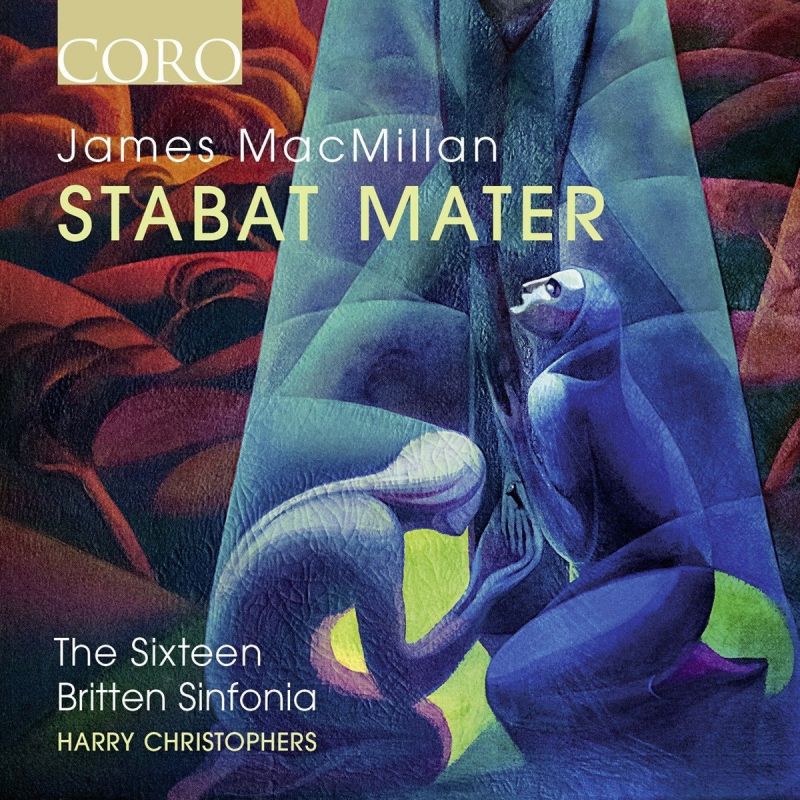MACMILLAN Stabat Mater
View record and artist detailsRecord and Artist Details
Composer or Director: James MacMillan
Genre:
Vocal
Label: Coro
Magazine Review Date: 05/2017
Media Format: CD or Download
Media Runtime: 60
Mastering:
DDD
Catalogue Number: COR16150

Tracks:
| Composition | Artist Credit |
|---|---|
| Stabat mater |
James MacMillan, Composer
(The) Sixteen Britten Sinfonia Harry Christophers, Conductor James MacMillan, Composer |
Author: Marc Rochester
The work owes its existence to the longstanding relationship between The Sixteen and James MacMillan. In 2001 the first ever new commission from The Sixteen was MacMillan’s O bone Jesu, and eight years later they gave the first-performance of his Miserere. On top of that, Christophers (the dedicatee of the Miserere) clearly has huge admiration for MacMillan’s sacred works, writing that ‘James ranks amongst a trio of truly great composers of sacred music, the other two being Tomás Luis de Victoria and Francis Poulenc’. Christophers’s adoration of MacMillan’s Stabat mater radiates out of every moment of this compelling performance.
Along with John Studzinski and his Genesis Foundation, Harry Christophers and The Sixteen have been encouraging living composers to set the Stabat mater on the grounds that, although it is one of the most powerful of all liturgical poems, it seems to have fallen out of favour in recent times. They point to just two notable settings from the 20th century, by Szymanowski and Poulenc. Three 21st-century composers with very different musical outlooks were invited to contribute settings, with MacMillan serving as a kind of composer-mentor, and the project culminated with MacMillan’s own extended setting of the text.
As you would expect from a composer whose Catholicism is such a powerful force in his creative process, this is a deeply personal setting. This is immediately evident from the impassioned, closely knit shimmering strings which create an unmistakable aura of anguish at the very opening of the work. That is not, however, what actually opens the disc. It is prefaced by The Sixteen intoning with eloquent gracefulness the ancient plainchant that presents in timelessly concentrated form the entire text MacMillan has set, and which also provides the basis for much of his own melodic material.
MacMillan divides the work into four distinct sections, each with its own particular musical character in reflection of the essence of the text, and his instinctive understanding of the power of music to express emotions beyond the text is perhaps the most compelling feature of this new setting. Otherwise, all the hallmarks of his style are here; the juxtaposition of aggressive, angry dissonances with almost naively innocent melodies, sliding tonalities, cluster chords, jagged, sparring rhythms and, most potently, a melding of sung text and orchestral texture. Many of the most intense moments come when the choir disappears and we are left with purely orchestral imagery. There is a tantalising moment at 9'36" of track 2 where the choir effectively slides out of sight while the violins swarm up in a haze of fluttering torment.
The Britten Sinfonia have tremendously incisive rhythmic bite – their jagged chords four minutes into the first section have almost percussive violence to them – and other effects, such as the swarming high violins at 9'04" in the ‘Sancta mater, istud agas’ (track 4) signifying the lamentations at the foot of the cross, are executed with a hair-raising fervency. Against this the ethereal violin solo at 8'15" in track 3, revealing its ancestry in the pastoral writing of Vaughan Williams, is positively mouth-watering in its loveliness.
We are so used to the excellence of The Sixteen that we are in danger of taking the supreme quality of their work for granted. But the closely knit choral clusters, ethereally drawn together with a remarkable unity of tone, and the intense, fervid textures, astonishingly nuanced, almost as if they are a single living, breathing entity, put them in a class of their own.
It is also dangerously easy to underestimate the consummate skill with which Harry Christophers balances and moulds the choral sound. From deep within this wonderfully homogeneous sonority, the solo voices emerge almost imperceptibly. All the soloists are outstanding; but if I were to single out one, it must be soprano Julie Cooper, who in the early stages of the second part effortlessly ascends to stratospheric heights in representation of Mary’s anguish.
Posterity might well judge this to be a 21st-century masterpiece; there is no question that this is a truly masterly recorded performance.
Discover the world's largest classical music catalogue with Presto Music.

Gramophone Digital Club
- Digital Edition
- Digital Archive
- Reviews Database
- Full website access
From £8.75 / month
Subscribe
Gramophone Full Club
- Print Edition
- Digital Edition
- Digital Archive
- Reviews Database
- Full website access
From £11.00 / month
Subscribe
If you are a library, university or other organisation that would be interested in an institutional subscription to Gramophone please click here for further information.




